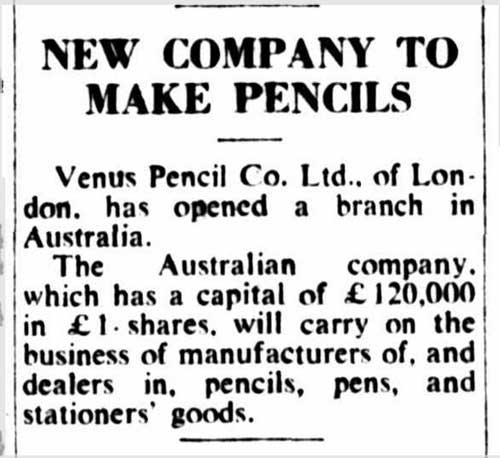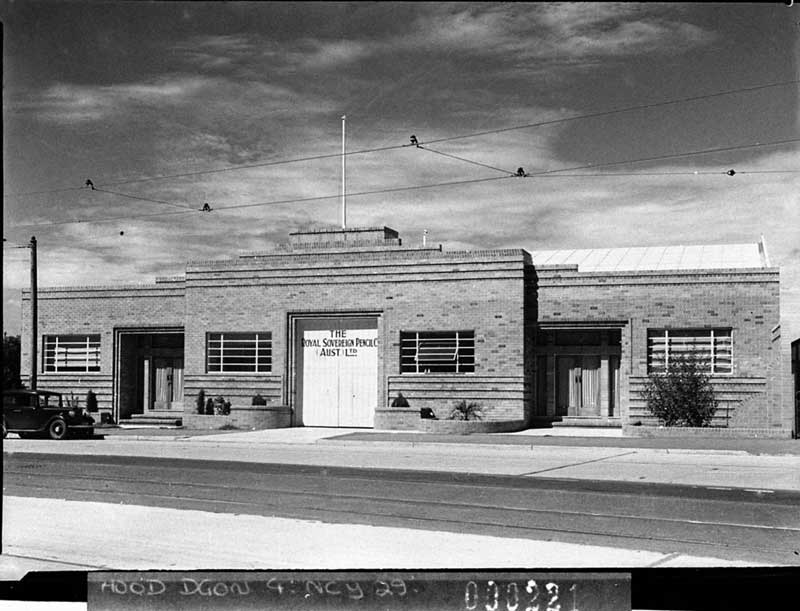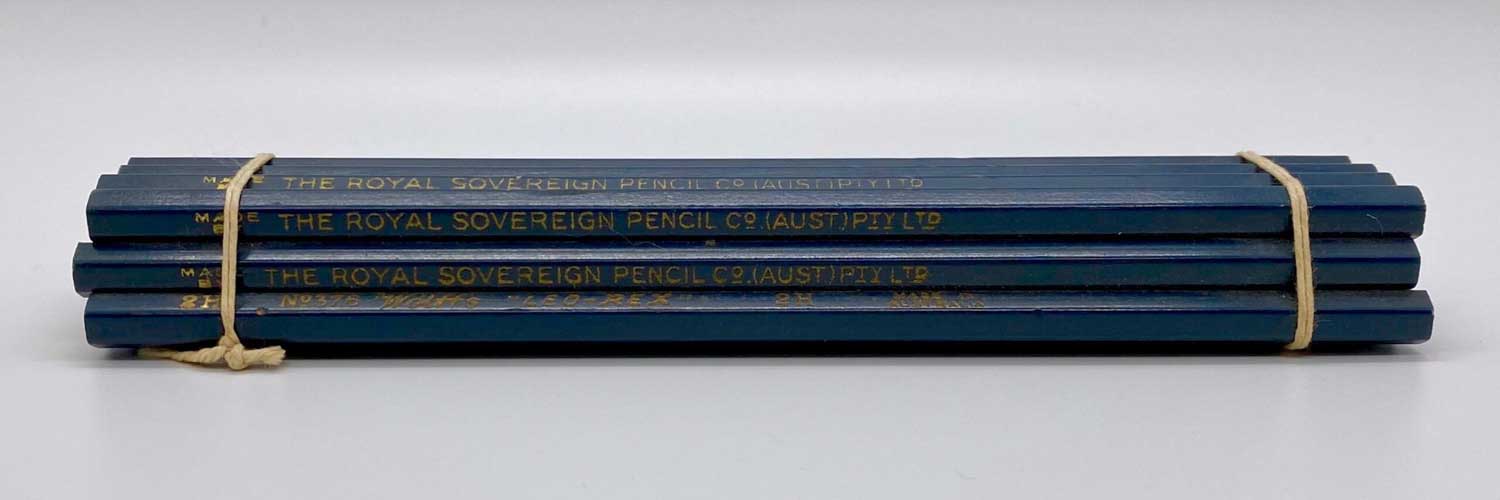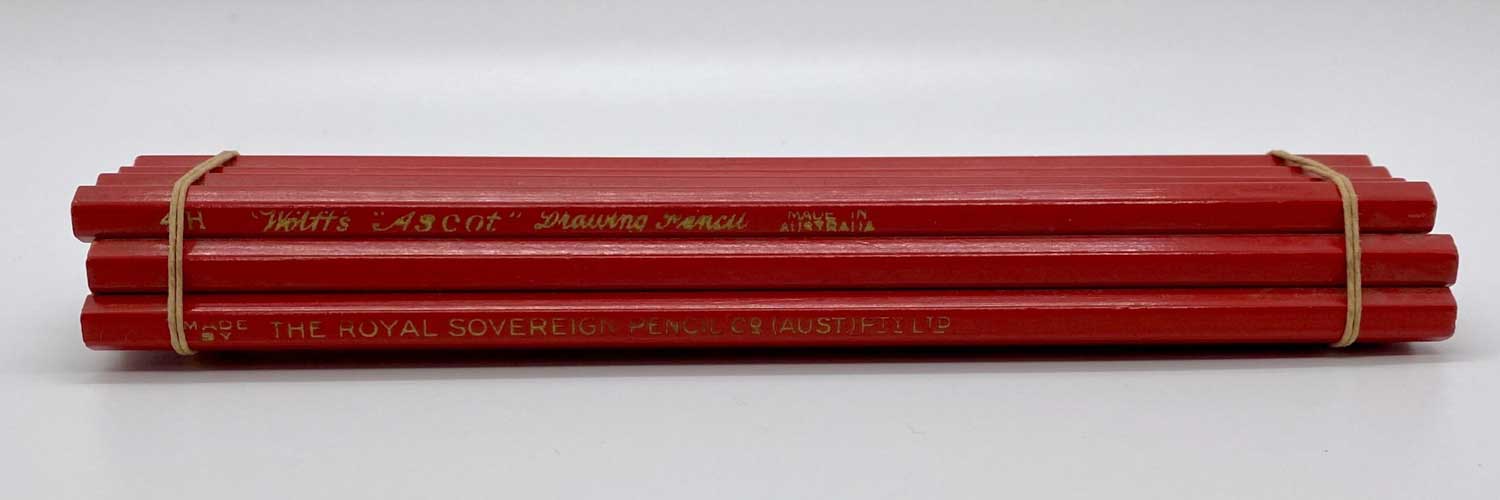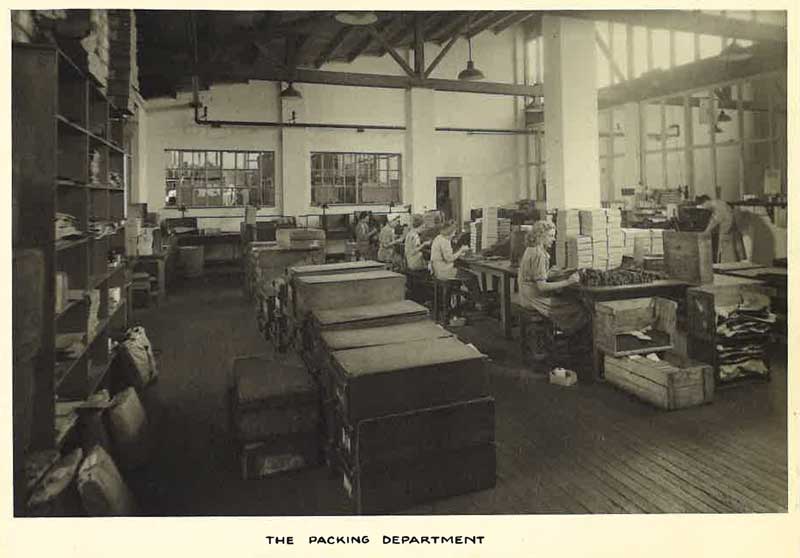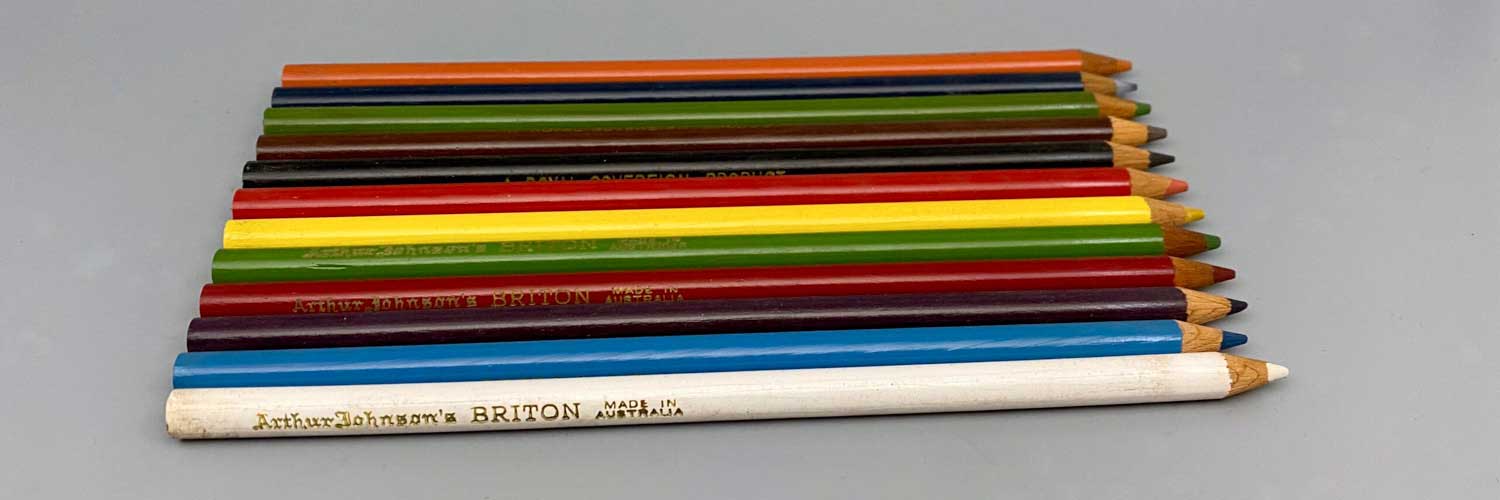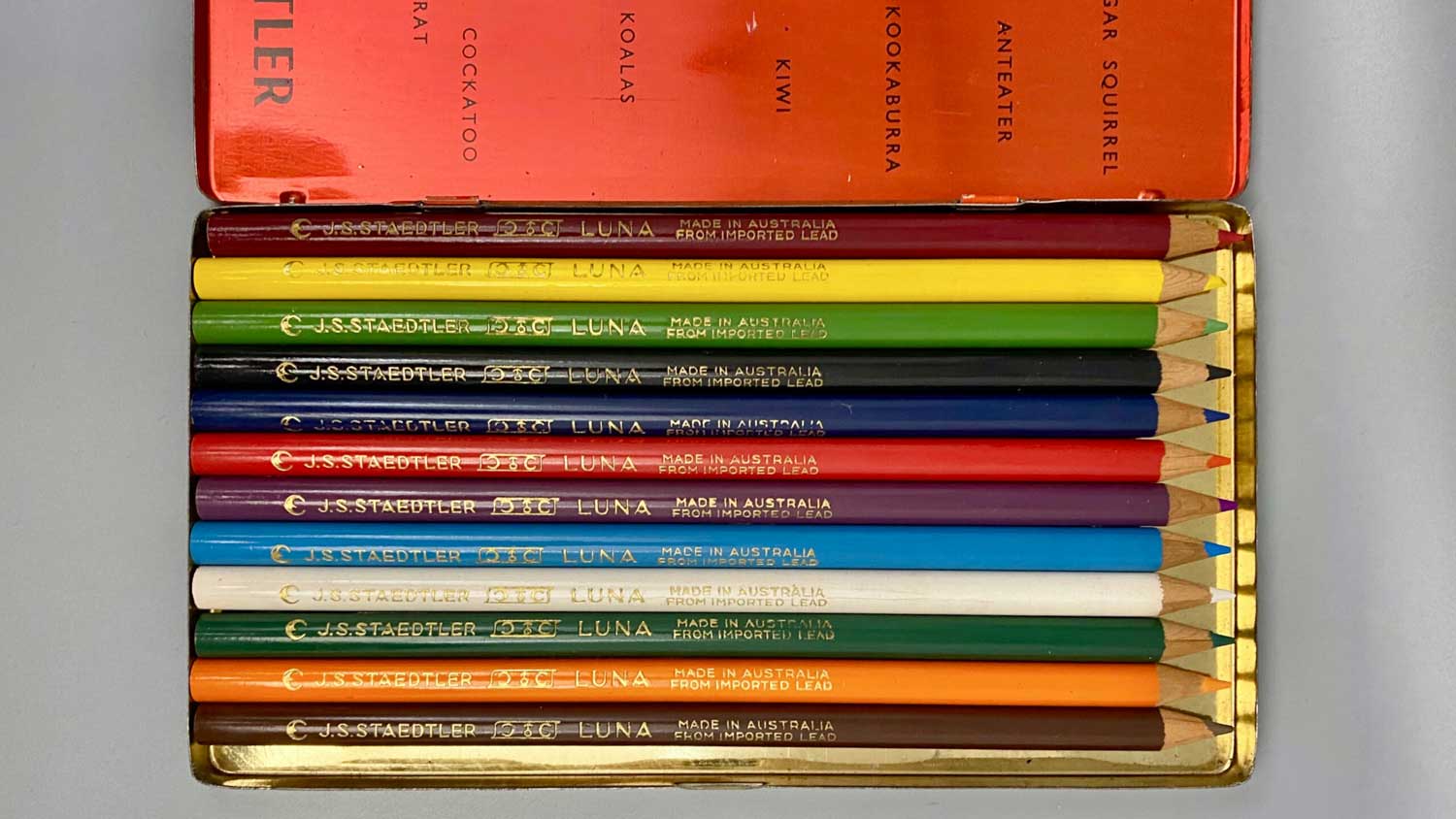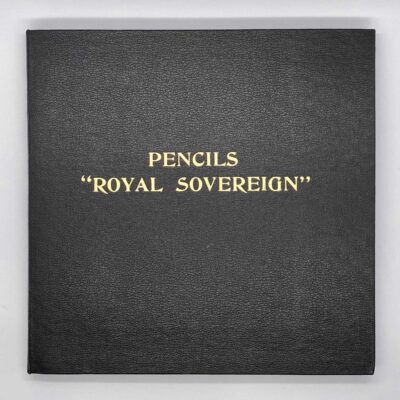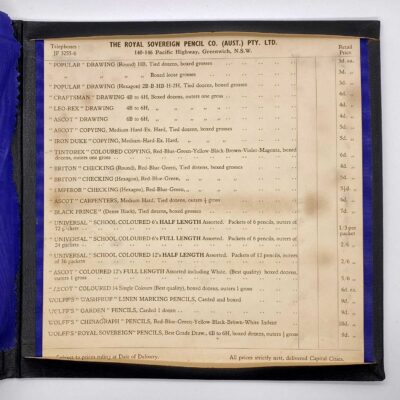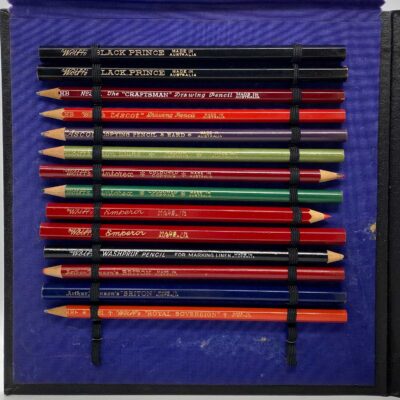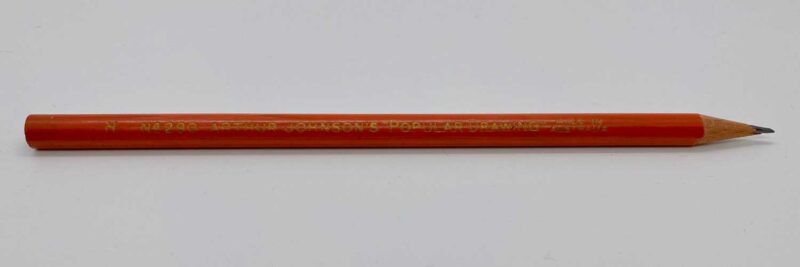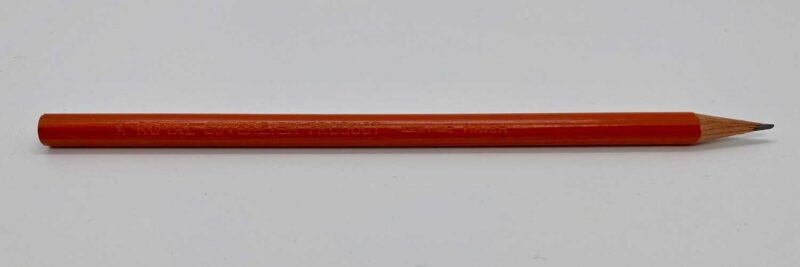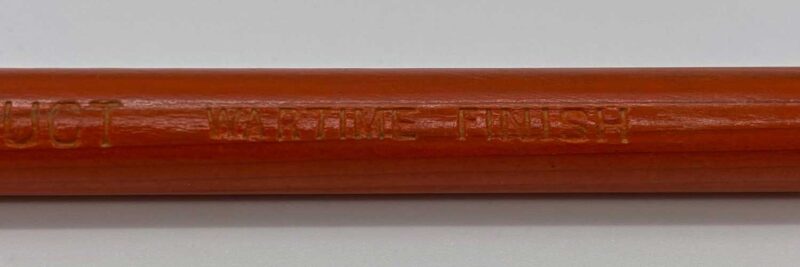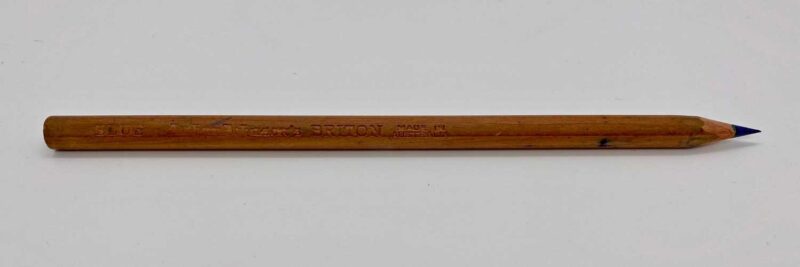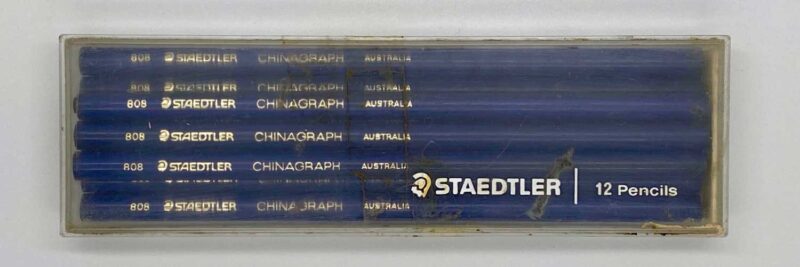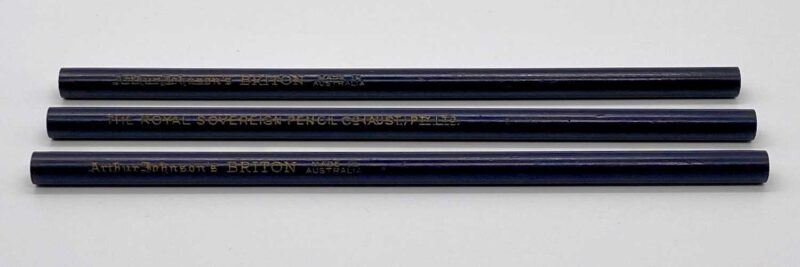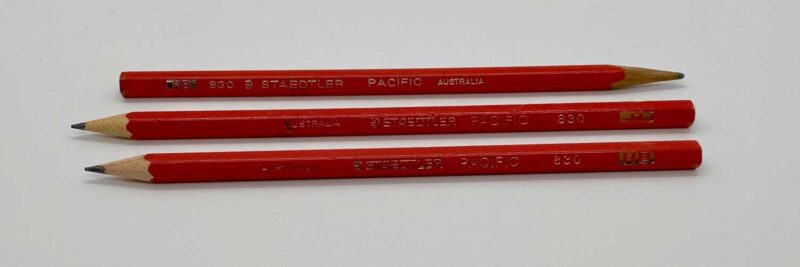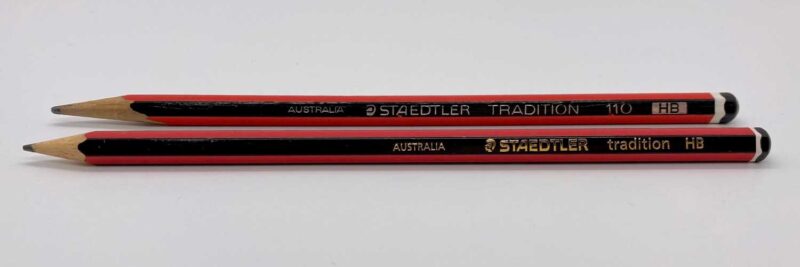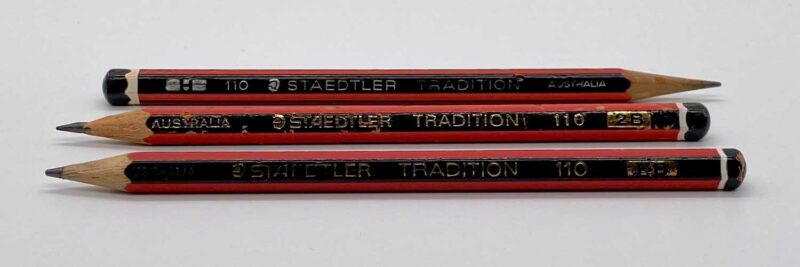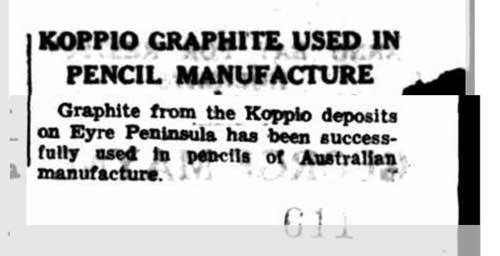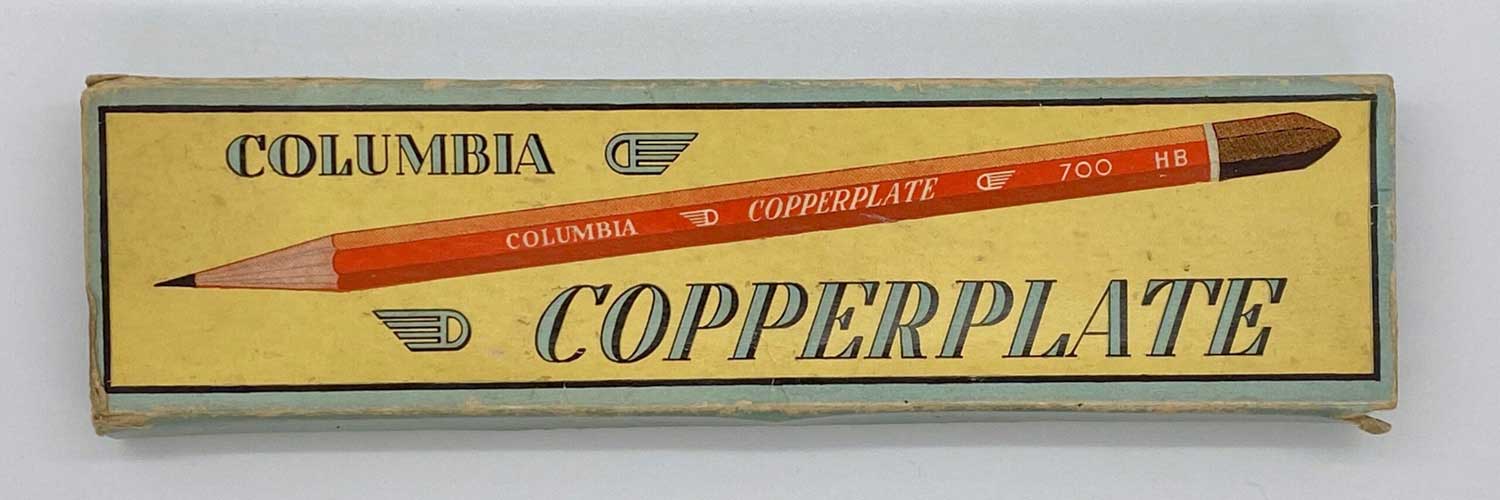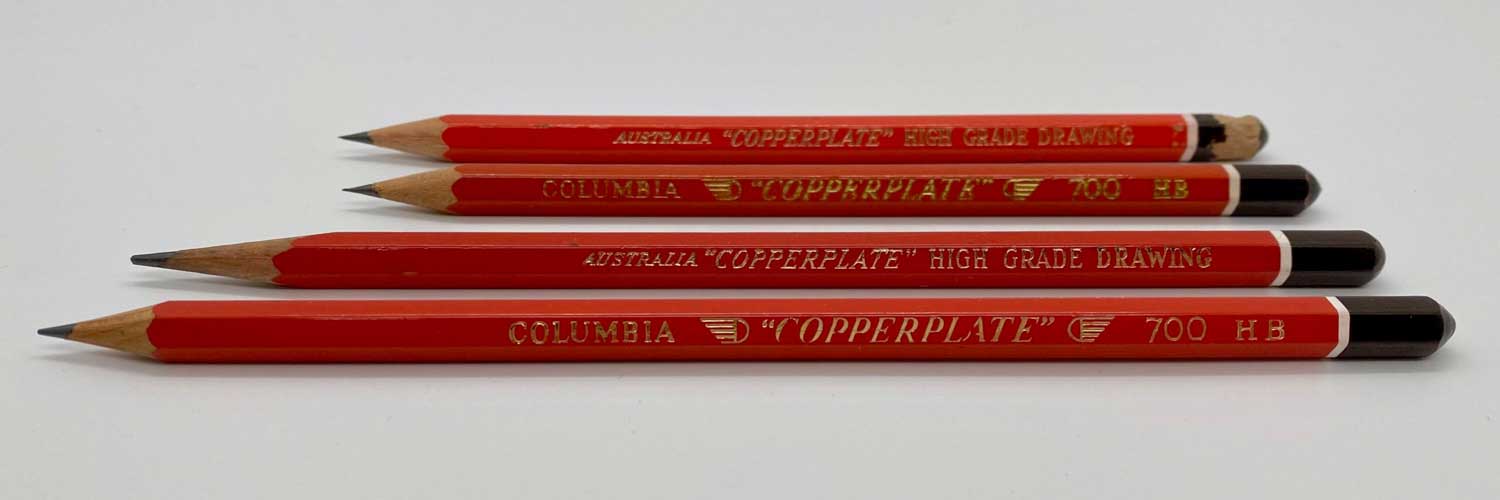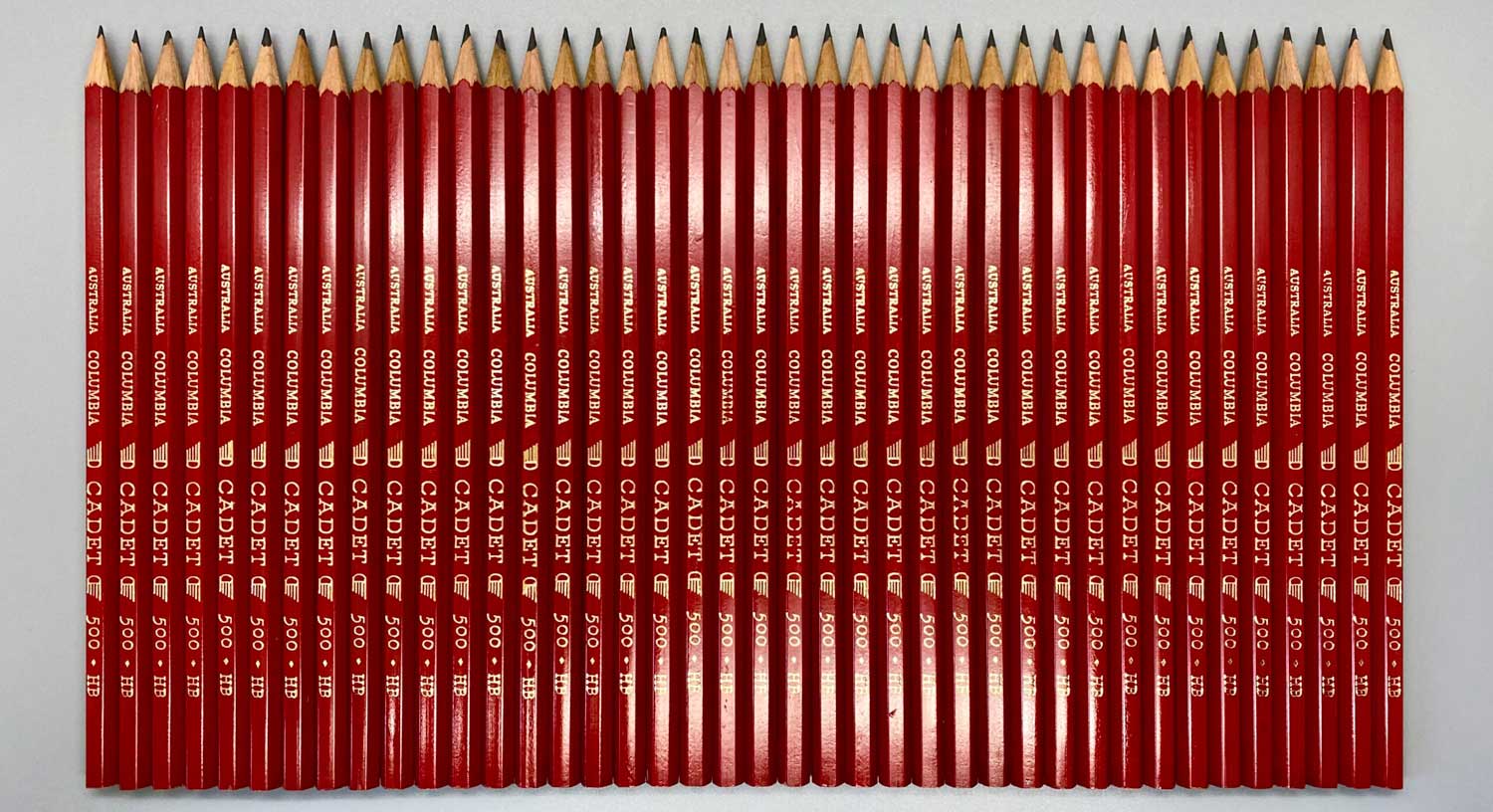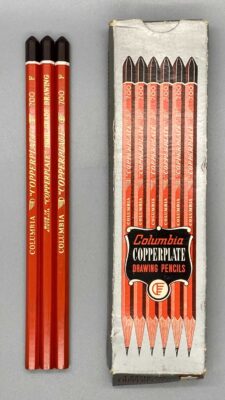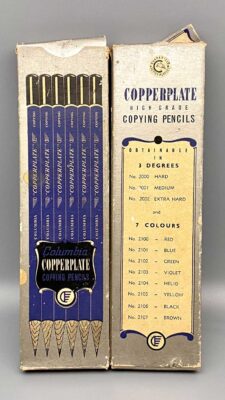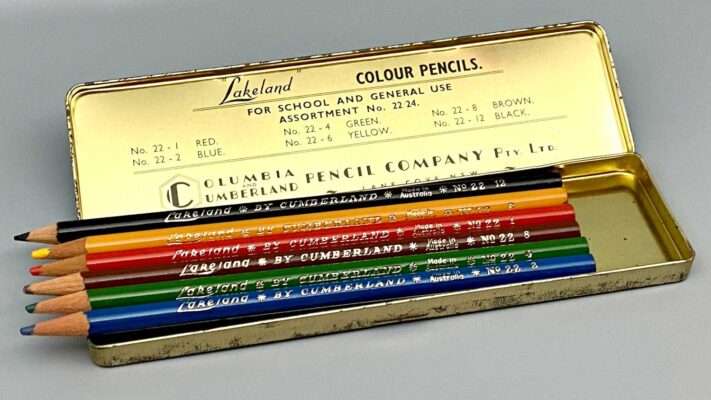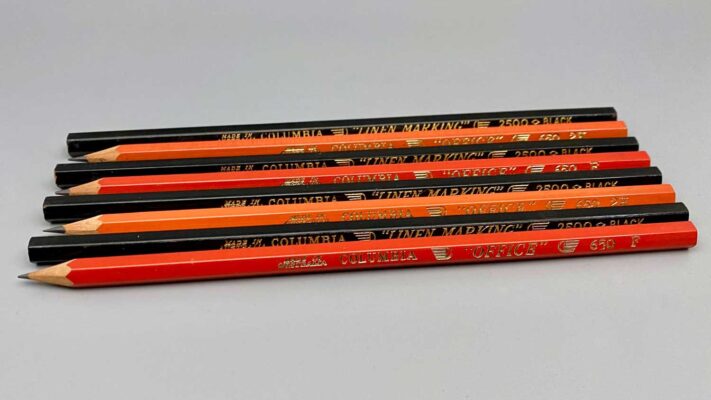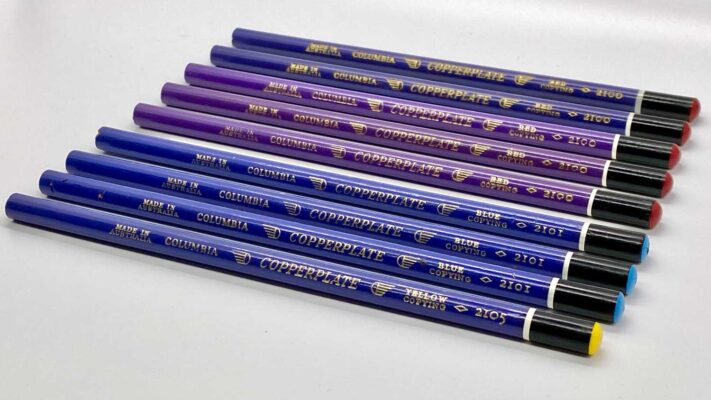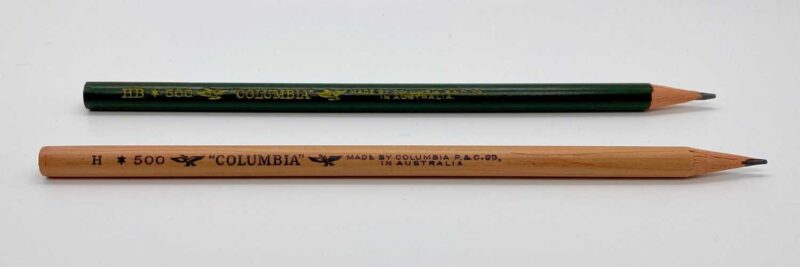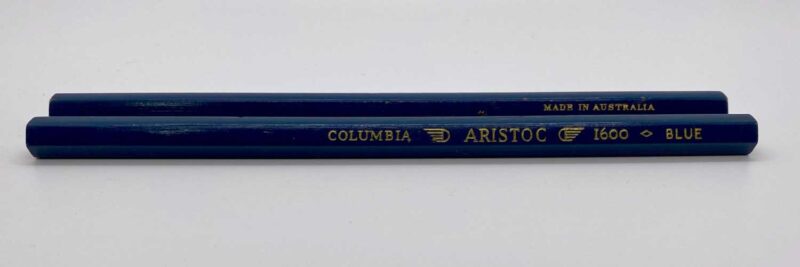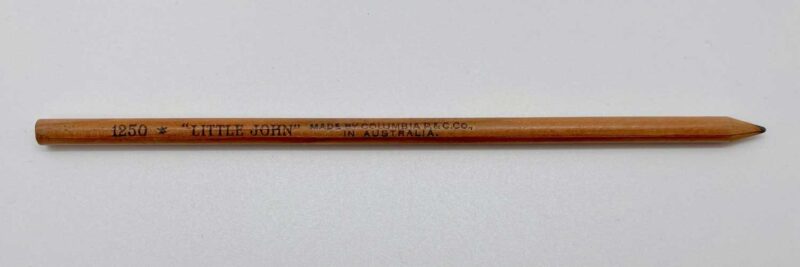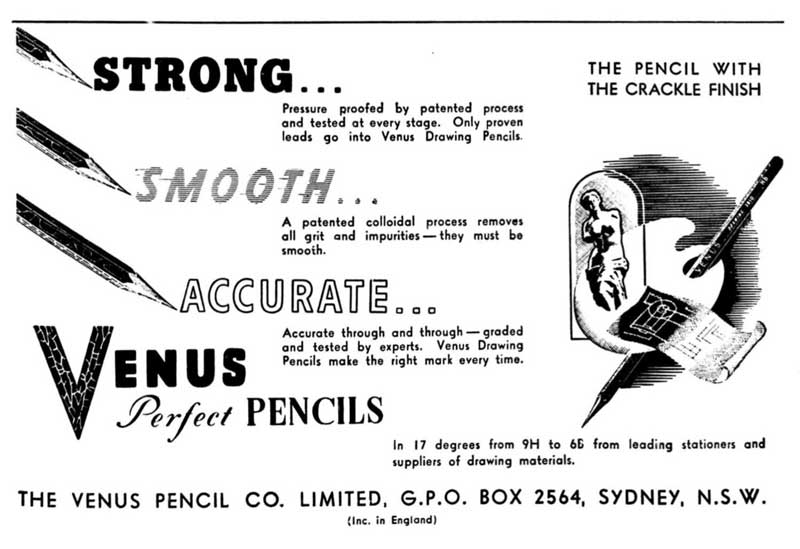Australian Pencil History
Updated June 2021
There are currently no pencil manufacturers operating in Australia, and the details of the companies that previously existed are difficult to come across. If you have anything to add to the below or have any Australian-made pencils you’d like to donate, please let us know.
Two pencil factories operated in Australia, both opening in the 1930s. The first, Columbia Pencil & Crayon Company, was a company first established in Australia. The second, Pencils Australia Limited, were quickly taken over by Royal Sovereign Pencil Company Australia, connected with the UK based Royal Sovereign Pencil Company. The details of these two companies are discussed further below.
The first documented mention of a pencil factory in Australia was on 7 December 1928 in The Sydney Morning Herald. Mr A. S. Peters, who ran the Royal Ensign Pencil Works from the UK, visited Australia and declared that a pencil factory could be established in Sydney if testing on local wood varieties found a suitable wood for local manufacture. Despite this declaration, Royal Ensign Pencil Works never opened any office or factory in Australia.
Testing on local woods was completed—with articles from May 1931 stating the Forest Products Division had been engaged to trial a number of Australian timbers to see if they would be suitable for pencil manufacture. Reports suggest that the search for a suitable Australian timber was unsuccessful, with articles from The Herald in 1947 stating that more than 32 types of Australian wood had been tested, but none were satisfactory. Australian wood was never used in Australian-made pencils, with both Columbia and Royal Sovereign importing American incense cedar slats for production.
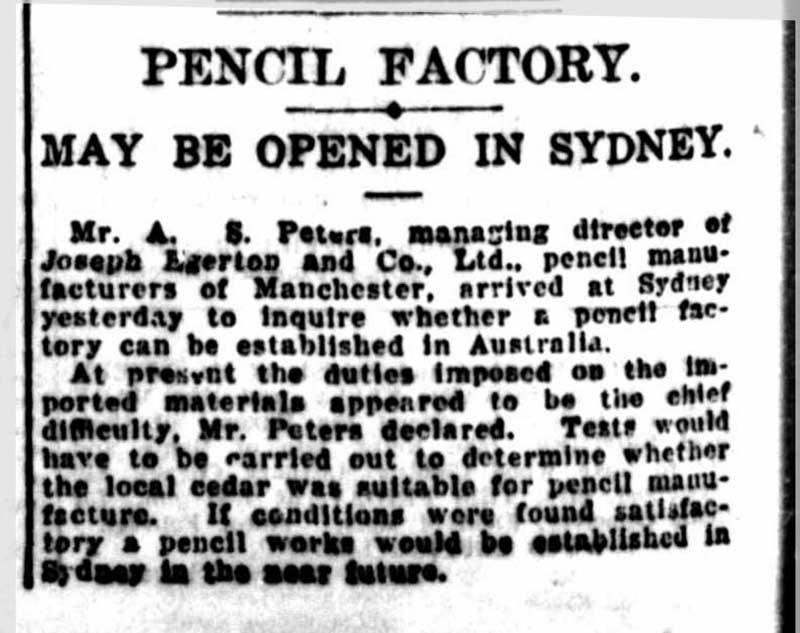
Royal Sovereign Pencil Co. (Aust.) Ltd. & Staedtler Australia
The Royal Sovereign Pencil Company was established in the UK in 1919 from a combination of The House of Arthur Johnson (est. 1803) and E. Wolff & Son (est. 1796), two British pencil manufacturers. Royal Sovereign pencils imported from the UK were sold in Australia as early as 1921, with ads encouraging people to stop buying ‘foreign’ pencils (presumably German pencils at the time) and to buy Royal Sovereign products.
In early 1931, the Managing Director of Royal Sovereign UK visited Australia. It was reported in an article from The Age that he discussed plans to open a pencil factory, likely in Melbourne, with work beginning after the ‘political atmosphere had cleared’, presumably referring to the circumstances surrounding the Great Depression.
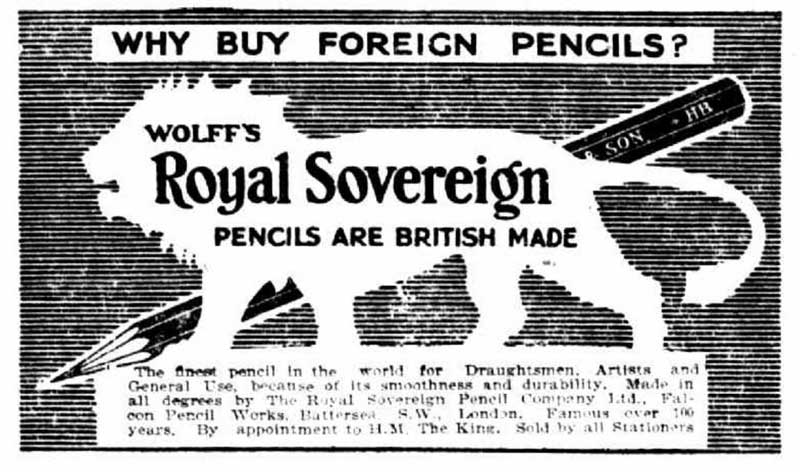
The Royal Sovereign Pencil Company (Australia) was registered on the 4 February 1931. At the time, Royal Sovereign was the largest pencil producer in the UK, and one of the leading manufacturers in the world. Their desire to open an Australian factory was to avoid potential future issues with tariffs on importing British made pencils into Australia.
In March 1931, the manufacture of pencils in Australia was started not by Royal Sovereign, but by a company called Pencils Australia Limited. Documents suggest they imported wooden pencil slats with leads already incorporated, finishing the pencils locally in Australia. Their business ran at a loss, and they went into liquidation in 1935 at which time they were taken over by the Royal Sovereign Pencil Company (Australia).
The Royal Sovereign factory was established in Sydney, not in Melbourne as originally anticipated, on the site of 140-146 Pacific Highway, Greenwich and opened in the late 1930s. The company produced a wide range of pencils in Australia, including:
- Royal Sovereign: Craftsman.
- Wolff’s: Alexandra, Ascot, Black Prince, Chinagraph, Diabolo, Emperor, Garden, Iron Duke, Leo-Rex, Royal Sovereign, Tintorex, Washpruf.
- Arthur Johnson’s: Briton, Popular.
Royal Sovereign used British imported pencil leads and incorporated them into American wooden pencil slats. Although the pencils were assembled and finished in Australia, neither of the major raw components were sourced in Australia. Royal Sovereign and Staedtler never used Australian graphite or wood in their pencils, aside from a period in 1947 when there was a major pencil shortage in Australia. During this time, Royal Sovereign purchased some Australian made leads from Columbia Pencil Company, and also imported some from the USA.
By 1938, Royal Sovereign was capable of producing over 10 million pencils annually, about half of Australia’s consumption at the time.
In 1948, two American pencil companies with factories in Britain expanded into Australia – Eagle Pencil Company of Australia Pty Ltd & Venus Pencil Co Ltd. These companies partnered with Royal Sovereign Australia, forming Greenwich Pty Ltd. Greenwich received pencil leads from Royal Sovereign, Eagle & Venus factories in the UK and assembled them into pencils in Australia using American incense cedar slats. These pencils were then marketed and sold by each of the 3 Australian companies independently. Each company used their own pencil leads and own branding, but all used the same wooden casing, and were all assembled in the same factory in Sydney. Both Eagle and Venus’ Australian companies went into liquidation in the early-mid 1960s.
In the early 1960s the Royal Sovereign Pencil Company in the UK went into partnership with Staedtler, eventually selling the entire company to them in 1966. At the time of the initial partnership around 1961, the Royal Sovereign Pencil Co. (Aust.) Ltd. became Staedtler Sovereign Pty Ltd.
By 1969, 30 million pencils were being produced in Australia between Staedtler Sovereign and Columbia, approximately half of the 70 million pencils purchased in Australia each year. It’s around this time that Staedtler Sovereign opened a new factory at 1 Inman Road, Dee Why to expand its production capabilities. Their products at the time included Tradition, Noris, Pacific, Elephant, Luna & Mars Lumograph pencils. Sometime around 1975, Staedtler Sovereign Pty Ltd became Staedtler (Pacific) Pty Ltd.
Staedtler continued operation in Australia until 2009-2010 when they closed their factory and warehouse in Dee Why. From that point, all Staedtler products sold in Australia were imported, with all Australian warehousing and repackaging operations outsourced. Today, Staedtler still operates an office in Australia at the current location of 18 Aquatic Drive, Frenchs Forest.
Columbia Pencil & Crayon Co. Pty. Ltd.
Columbia was founded by George H. Horton and has its beginnings as far back as 1919, importing and distributing carbon papers and inked ribbons from the Columbia Ribbon & Manufacturing Company, New York. In 1931, after acquiring the machinery and materials, they began manufacturing their own carbon paper and inked ribbons under licence from the New York company in their location on City Road, Sydney.
In 1935, they started taking steps to produce wood-cased pencils and in 1936 began production using leads imported from the Empire Pencil Company in the USA and American incense cedar slats. By 1938, Columbia was capable of producing over 10 million pencils annually, about half of Australia’s consumption at the time.
In 1940, they moved production to a new factory at 183 Botany Road, Waterloo; however, they quickly outgrew those premises as they were still producing carbon paper, inked ribbon and even player piano rolls at the time. The site of the old factory is now a McDonalds, and the curved factory entrance can still be seen as a gateway into the carpark.

Columbia spent time producing a small amount of Australian-made pencil leads, and in 1944 decided to expand their production to become completely self-sufficient and no longer reliant on overseas graphite. The source of the graphite used in their pencils is unclear as graphite mines were established across the country, however the Koppio Graphite Mine in South Australia is documented to have supplied to the Australian pencil industry.
On 30 May 1947, Columbia printed an abridged prospectus in The Sydney Morning Herald, advertising they had issued 150,000 shares for £1 each to become a public company. The money raised would be used to complete a new factory in Lane Cove, Sydney, and for the purchase of plant machinery and equipment. The Lane Cove factory would initially be used for the manufacture of pencil leads and eventually would house all their manufacturing.
When Columbia opened their new factory, it marked the beginning of the mass manufacture of pencils in Australia. At the time, they were the only manufacturer of pencil leads in the Southern Hemisphere. Their initial lines produced in Sydney included Copperplate (700), Cadet (500), Formative and Colour Sketch varieties—all still available today, although no longer manufactured in Australia.
The Columbia Pencil & Crayon Company continued to grow —by 1949 they had manufactured over 200 million pencils and were exporting to New Zealand, South Africa, India, British Malaya (parts of Malaysia and Singapore) and the Dutch East Indies (Indonesia).
Over the years, several other pencil models were released and discontinued, including Aristoc, Copperplate Copying (2000, 2002, 2100), Linen Marking, Little John, Meridian, Number One, and Office.
Their corporate ownership is a little unclear, but it seems they went through a number of mergers and acquisitions.
At some point prior to 1970, Columbia joined forces with the UK Cumberland Pencil Company (who eventually became Derwent), becoming Columbia & Cumberland Pencil Company Pty Ltd. They later became Columbia Pelikan Pty Ltd (with Pelikan Artline) and were passed through Esselte Australia with some of their pencils branded ‘Esselte Dymo Australia’. In 2016 they became wholly controlled by ACCO Brands, an American publicly traded company which own brands such as Derwent, Marbig & Rexel.
At some stage during their history, they closed the Sydney manufacturing plant and moved production overseas. Today, Columbia pencils are still readily available at Australian retailers – however they no longer use Australian-made leads, and no longer have any connection to Australian ownership.
Other Australian Manufacturers
Two other international pencil manufacturers originally from the USA but with factories in the UK formed companies in Australia. Eagle Pencil Company of Australia Pty Ltd was registered on 11 November 1948 and Venus Pencil Co Ltd was registered on 7 January 1949. These two companies partnered with Royal Sovereign Pencil Company to create Greenwich Pty Ltd. Greenwich was essentially a pencil assembly factory which used American incense cedar slats for all three brands of pencils.
Eagle, Venus & Royal Sovereign imported their own pencil leads from their British factories, but all used Greenwich’s factory in Sydney to assemble their finished pencils – using their own branding. These pencils were then marketed and sold by each of the three Australian companies independently.
Venus branded pencils made in Australia include the Autograph, Service Blue, Service Red & Special Drawing pencils. Venus’ Australian company was dissolved in 1962-1963. The parent USA division of Venus was eventually acquired by Berol, Faber-Castell & Sanford Corporation.
Eagle branded pencils made in Australia include the Carpenters & Sun pencils. Eagle’s Australian company went into liquidation in March 1967. The parent USA division of the Eagle Pencil Company was also acquired by Berol and then the Sanford Corporation.
